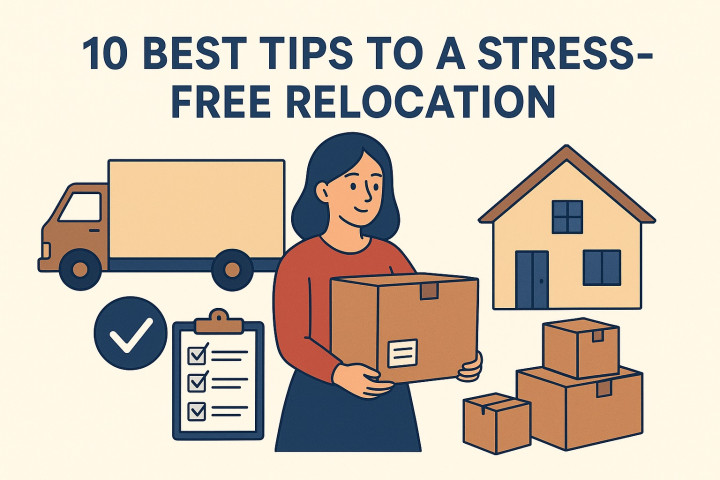-
-
-
GSTIN. 27BTUPA9902P2ZU




10 best tips to a stress-free relocation with packers and movers.

- 2025-10-18 06:48:10
- 357
10 best tips to a stress-free relocation with packers and movers.
Moving to a new place of residence or office is not simply a physical exercise, but a life event. Although a new beginning is a great idea, getting there, can be so stressful. But that does not necessarily have to be the case. Planning and organizing and collaboration with the correct professionals is the key to a successful transition.
Being the foremost packers and movers in the business, we have conducted hundreds of relocation processes and have witnessed what can transform a messy relocation process into an honest and smooth one. These are our top 10 insider tips to a stress free relocation.
1. Begin at the very beginning and design a Master Plan.
The last-minute rushing is the largest contributor to stress-inducing movement. You should start planning at least 6-8 weeks ahead of time.
Your Action Plan: Prepare a moving checklist or go online to a calendar to map all your activities in the course of every week. These are researching relocating companies, clearing out, packing non essentials and establishing utilities in your new residence. A visual timeline also removes the worry of forgetting an important thing.
2. Marriage Make-Over: Pack Light, Pay Light.
This is the golden rule. All the things that you do not move are money that you save on packing materials, labor and transportation.
Your Action Plan: Look in each room with 4 boxes: Keep, Donate/Sell, Recycle, and Trash. Be honest with yourself. Have you used it in the past one year? Is it something of great worth, or of gladness? If not, let it go. A reduced weight translates to a reduced bill and a new beginning.
3. Select Your Moveming Lover Well.
The experience you have will depend on the packers and movers that you select. It is not a case of the lowest price quote.
Your Plan of Action: Find the IBA-approved companies that have the confirmed license and insurance. Read new customer reviews and request referrals. To give a clean and transparent quote without any hidden costs, a reputable company will insist to survey your goods physically or using video.
4. Meet with Your Movers Before the Move.
The key to a seamless transition is good communication. Do not think they know it all.
Your Action Plan: When you have hired a company, take them through your home. Indicate items of high value, delicate antiques, and other access issues such as low-hanging trees, and narrow staircases. This will make them be equipped with the appropriate equipment and materials.
5. Prepare an Essentials Box, Open First.
Think of getting home to your new place, when you are hungry and exhausted, and a mountain of unopened boxes greets you. Your immortality bag is this single box.
Your Action Plan: Prepare a well-marked box with all the things you will need in the first 24 hours. This involves toiletries, change of clothes, medications, phone chargers, pet food, basic tools, snacks and above all, a kettle of coffee or tea. Make sure this box is loaded at the last moment on the truck so it is the first one to be off-loaded.
6. Master the Art of Labeling
A step in the right direction is writing "Kitchen" on a box, but labeling on a professional level is a game-changer to unpacking.
Your Action Plan: Use a bold marker to write on each box on its top and sides. Add the room in which it is located and a short overview of what is found in it (e.g., "KITCHEN - Pots and Pans). Better still, have a color-coded sticker system, a code on the different rooms. This will save time as movers are able to place boxes in the right place without having to be questioned all the time.
7. Make Photos and Keep Significant Information.
Some of your most useful products are not tangible in the age of digital technology.
Your Action Plan: Make the photos of the reverse side of your TV, computer and other electronics to be able to remember where all the cables were. Copy all the valuable computer data onto a cloud service or external hard disk drive, which you will carry by yourself. In addition, record pictures of valuable things to use as a form of insurance.
8. Personally treated Valuables and Documents.
Although there is insurance on professional movers, there are some things that cannot be replaced.
Action Plan: Pack an emergency moving bag that does not come on the truck. This ought to consist of jewelry, birth certificates, passports, medical records, financial documents, house keys and valuable family items. This bag should always be with you.
9. Prepare Your Family and Pets
Relocation is disturbing to children and animals who are comfortable with order.
Your Action Plan: Discuss the move with your kids far ahead of time with emphasis on the good things. When they are moving on a moving day, have a friend or family member take care of them, where possible. In the case of pets, they should be kept in a small, enclosed room containing food, water, and a favorite toy on the moving day to ensure that pets are not frightened by the unfamiliar environment and escape via an open door.
10. Check, Clean and Open Final Inspection.
It is not finished until the very last box is off the truck.
Your Action Plan: The inventory list verification Be present to check as the items are unloaded. When you are done, give a cursory cleaning of your old place of abode to make sure that you have nothing left behind. Lastly, do a walk through with the head mover. Look at the possibility of any damage and make sure you hand over all the contact and claim information before the crew departs.
Relocation is best a symphony not a solo performance. With these guidelines and a reliable, professional packing and moving service, you will turn what would have been a stressful experience into an organized, efficient, but even exciting experience into your new starting point. Keep in mind, it is not only about transporting your possessions, but also about the transfer of your life without any inconvenience and any doubts.
